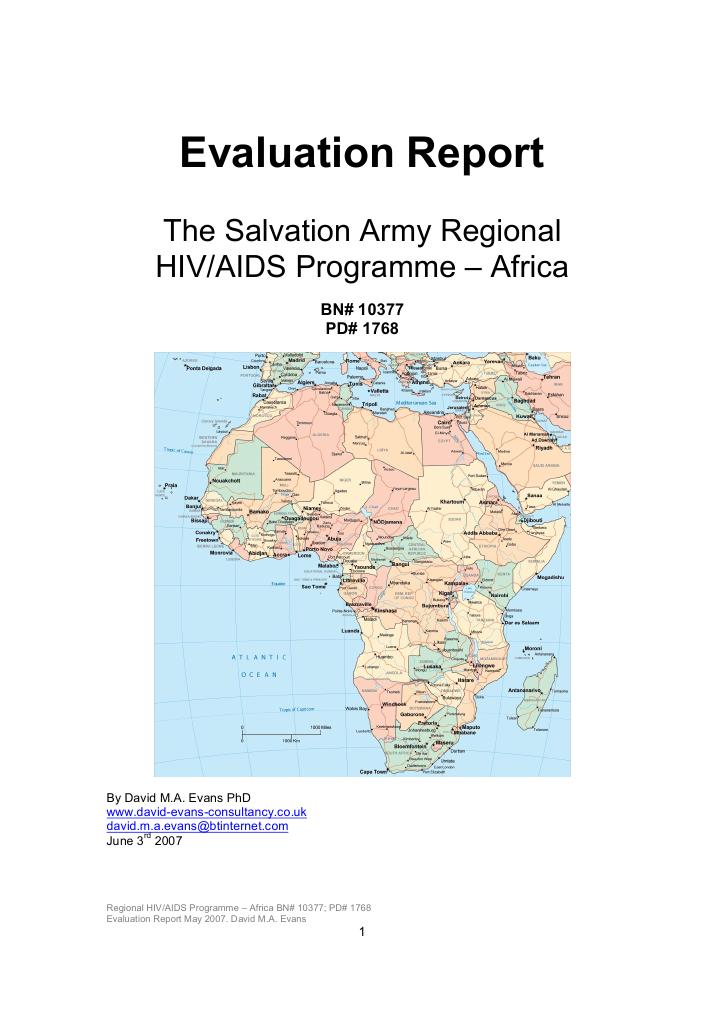Evaluering
Evaluation Report. The Salvation Army Regional HIV/AIDS Programme- Africa
Background The underlying philosophy of the Salvation Army's approach is the creation of 'AIDS and life competence' within communities. Creating AIDS and life competence is acknowledged to be done most effectively when community efforts are facilitated rather than directed, thus building community ownership. Purpose/objective The report evaluates how well the Africa Regional HIV/AIDS Programme meets the objective of facilitating the creation of AIDS and life competence in local, country and regional levels within the Salvation Army across 18 countries in Africa. Methodology The evaluation visit took place during May 2007, and involved accompanying members of the Regional Facilitation Team (RFT) and local facilitators to three communities in Kenya and three in Rwanda. The main method was in-depth discussions with RFT members, members of Territorial Facilitation Teams and local corps facilitators, as well as local and country leadership. The evaluators also visited various communities and programme activities. Key findings • The key strengths of the RFT approach are that local communities are being animated to respond to local concerns and that many of these ways are increasing AIDS competence, but that more critically, the approach has an built-in ability to spread rapidly through the resource pool of facilitators that continues to develop rapidly across the region. As such, the approach is being effective at a scale rarely achieved elsewhere.• Another impressive finding is the discipline of reflection by activists at the grass roots and documentation of results, impact, and learning.• The lessons learned and principles applied to increasing AIDS competence are being applied and transferred to other areas of work.• The RFT approach is resulting in the rapid growth of both the demand for accompaniment and also the supply of facilitators into the resource pool across the region. Recommendations • Developing deeper understanding of factors which encourage and hinder effective responses by 1) developing a mapping tool which captures the influence of other NGO interventions as a predictor of the capacity of communities to respond to local concerns, 2) explore the precise nature of how local facilitation as an approach stimulates people to take action, and 3) create timelines for all communities where facilitation teams have been accompanying local responses for over five years, focusing on factors which influence the progress and sustainability of the work.• Consider the factors which mitigate for greatest continuity of positive local responses during times of change in leadership and other aspects of local life and document the learning from such reflections, so that resilience of corps and local community responses is developed.• Explore best practice in volunteer management to refine current management• Improving self-assessment, participatory documentation and measurement of impact, by 1) improving the consistency of what activities are routinely assessed, and ensure that each activity is carefully defined, 2) developing and using objective descriptive benchmarks to create self-assessment frameworks, 3) ensuring the routine and rigorous use of tools which help to document and thereby quantify qualitative data in all SALT (support, appreciate, learn, transfer) visitations and 4) by ensuring that when guidelines and 'manuals' are developed at various levels, they are shared as widely as possible across the region so that they can be expanded to reflect the fullest variety of practice.• Review the database of facilitators to ensure it is capturing the story of growth in numbers, transfer, personal development and competencies in the most objective terms as possible.• Assess the quality and consistency of mentoring support provided across the resource pool of facilitators, and ensure that a common understanding of what mentoring involves and how it benefits people is created and effectively communicated.• Consider how competence self-assessment frameworks can be adapted to be able to assess changes in aspects of community cohesion, resilience and local 'social capital'.• Clarify and document the process in which emphasis has shifted from the RFT specifically being a means of developing AIDS competence to a 'diversified facilitation team identity'.• Develop the means of explaining the concepts and methodologies involved in the Salvation Army approach to integrated mission simply and concisely as a means of speeding up support and commitment both within the Salvation Army and beyond.• Initiate a dialogue with BN/NORAD which results in the design of a process to enable other BN/NORAD partners to be exposed through a SALT visit process at the grass roots to the realities of the Salvation Army approach to integrated mission generally and to AIDS competence specifically.
